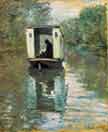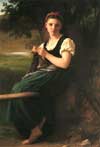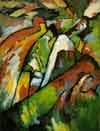| | ... Here's Chaos! (anarchy - page2)
After three or four centuries of Western painting and sculpture concerning themselves with the illustration of a simulated scene, representing fantastic mythology, political persons, environments or family portraits, the lines that defined conventional art began to fuzz. |
|
|
|
 | | | | Impressionist painting and Post-Impressionism, like the works of Monet, Renoir, Degas, Cezanne and Van Gogh, brought about a shift away from a focus on depicted subject matter, and christened a new canon for Western art that focused on how subject matter could be depicted.
| 
| The 20th century art critic Clement Greenberg disapproved of Kitsch art, work that represented traditional subjects, and did not visually live up to avante garde, modernist conventions. | Claude Monet
"The Boat Studio"
1876
|
|
| Kitsch
(as seen by Greenberg) |
| Avante Garde
(as seen by Greenberg) |
| 
Boug
uereau
"The Knitting
Girl" 1869
| 
Kandinsky
"Improv-
isation 7"
|
|
| Modernism was a 20th century overhaul of traditions. Work like that of Matisse, Picasso, Kirchner, Kandinsky, Mondrian, Pollack, Brancussi, and many more incarnations of modernism, tended to favor some degree of visual abstraction and stylization, for the sake of conveying the essence of an idea. |
|
|  Every one of these art movements ending in "-ism" claims a new aesthetic territory that reinvents how the form of art serves its content. Every one of these art movements ending in "-ism" claims a new aesthetic territory that reinvents how the form of art serves its content.
| 
Henry Moore
"Reclining Figure"
1939
|
|
| Jacob Lawrence
"They Were
Very Poor"
1940-41
|
| In the 1950's, the work of Robert Rauschenburg often flew in the face of Greenberg's puritanical philosophy of art. Rauschenburg's and Jasper Johns' work often attended to recognizable and iconographic imagery. This rebellious trend exploded into Pop Art; the work of Andy Warhol, Roy Lichtenstein, Gary Indiana and many others, depicted imagery that was commonplace. Often, they were images found in commercial media. |
|
|
| |
|
| The examination of commercially tied imagery through art made some waves with modernist critics and the denizens of high art. The modernist trend posited that art should strive to be free of ties to any representation other than the intrinsic qualities of the work itself. Pop Art (which thankfully doesn't end in "-ism"), with its ties to obvious visual subject matter, and certainly ties to mass-produced, commercially engendered imagery, threw into question what types of imagery were worthy of consideration as art. | Jasper Johns
"Painted
Bronze"
1960 |
|
|
| The art world has grown more and more schizophrenic since then. The end of the 20th century has seen many traditional standards break down. For example, many pay respect to graffiti, tattoo art, comic books and commercially published work, found objects, happenings, industrial and commercial design, animation, and interactive work as art forms.
So, where does our definition of art end up? Who cares?!!
My suggestion is not to dwell on labels too heavily. Any creative gesture can be rationalized as art if you try hard enough, so enjoy what you like, hate what you hate, and let the Ministry of Art and Culture worry about categories and definitions.
(back to anarchy! page 1)
|
|
|
|
|
|
|
|
|